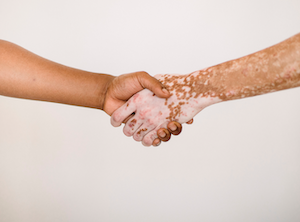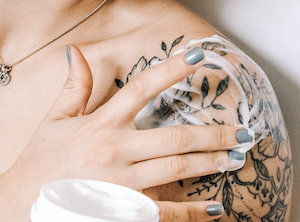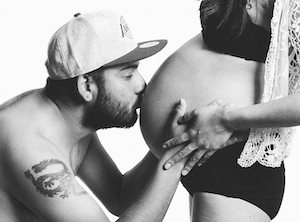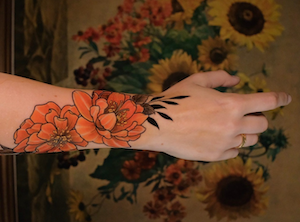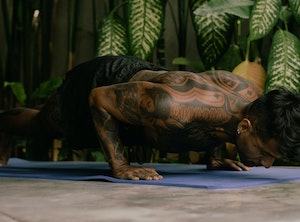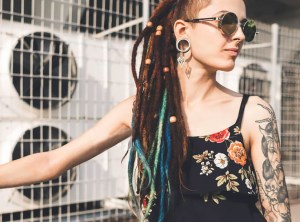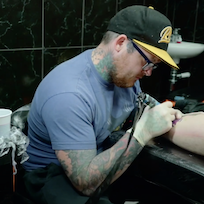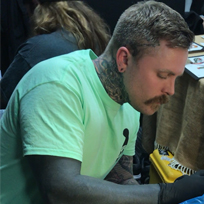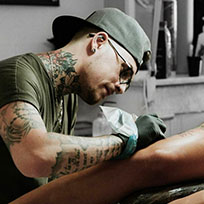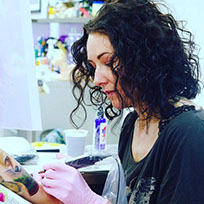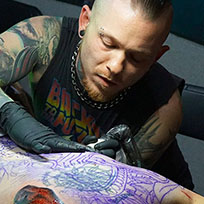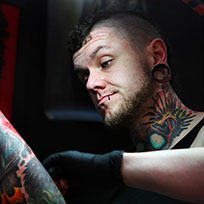Tattoo aftercare shouldn’t be taken lightly. If you want your ink to last, and we’re talking for a lifetime here, it’s important that as much respect is given to tattoo aftercare as is the tattoo process itself. That means taking care and attention and using the best tattoo aftercare cream for your skin.
You need to think of a tattoo for what it is: an open wound. The tattooist will have broken the skin with a needle leaving it vulnerable to infection. Although the artist should have done everything in their power to ensure their environment is hygienic and sterile, as soon as the client walks out of the studio, it’s then their responsibility to make sure it’s well taken care of. If you’ve spent the time choosing the right tattoo style for you and the right tattoo artist, you’ll want to spend that extra bit more to make sure it’s given the best chance for healing.

How to look after a new tattoo
Your artist will wash and wipe your newly finished tattoo with their chosen hygienic soap or antibacterial wash. Be warned it stings! What they advise next will depend on what they’ve had the best experience with based on their tattooing, as well as the size and placement of your tattoo.More than likely, they will then wrap it in some form of cling film or some kind of ‘second skin’ (like a sticky-back plastic that will stick to your skin but not to the wound) will be used to then wrap your tattoo. Dermalize is probably one of the most well-known second-skin products but we’ve also seen great results from Tattoomed.

How long the tattoo should remain wrapped depends on what the artist has had the best experience with for their work, as well as the size and placement of the piece. They will know best for their work so you should listen and take note.
Some may advise to leave the tattoo wrapped for a few hours, some 24 hours (second-skin stays in place well for a good while and is absolutely fine to leave on for a little longer).
In general, there are a lot of different recommendations out there so here we’ve summarised the best aftercare tips for tattoo healing…
- Do as your artist tells you. They will advise you of how long to leave it wrapped, what to expect and maybe even some aftercare products they’ve had good experiences with. They know best.
- Wrapping. Don’t re-wrap unless advised to do so and only if the tattoo is still moist. If it’s already dried out, best to leave out in the air.
- The first wash is really important. When you come to your first wash, most likely when you’ve just taken the wrapping off, there will be a syrupy, sticky layer over the top comprised of ink, blood, plasma and lymph fluid – all completely normal things for a new tattoo but you want to get rid of as much of it as you can. Using your (clean) fingers only, gently wash the area using warm water (not hot) until you can feel the syrupy layer has gone. If any of this layer remains, your scabs will be thicker which in turn will make it harder to penetrate any kind of aftercare products through leading to increased dryness and scab-cracking.
- Don’t use a towel. No matter how clean you might think it is, it will always have picked up some germs along the way. Anything with an abrasive surface as well (even a towel) will not be gentle enough and it could leave fluff residue within your tattoo.
- Choose your aftercare product. There are a whole host of fantastic aftercare products out there – we’ve listed some of our favourites below. Whatever you choose, be sure to avoid fragrance and alcohol-based products and make sure you don’t use too much of it. Your skin needs to breathe, but if it’s drowning in a tattoo aftercare balm it won’t be able to do so. Your pores could also become clogged leading to spots. Eww.
- Take aftercare cream with you everywhere. You don’t want to get caught out when you’re away from home for the day and start to feel your tattoo getting a little dry and tight.
- Think clean. Make sure you’re washing your tattoo at least twice a day and you should only be touching your tattoo with clean fingers. If you work in a dirty or active job, you might want to take some time off, or if you have to wear a grubby uniform. Second skin products like Dermalize and Tattoomed, as mentioned above, are a good idea if these situations can’t be avoided.
- Don’t rub. Don’t itch. Only pat. Scabbing is all part of the healing process and you want to make sure these stay on for as long as they need to be there.
- Don’t drink alcohol but make sure you’re taking on plenty of water. Alcohol thins your blood and prevents scabs from forming properly so you’re tattoo will be exposed to mother-nature and all her germy wonders for longer. If you’re drunk, you could also accidentally bump your new ink and cause it further injury. Water however, is exactly what you need. Drink plenty of it to help with your overall well-being and healing.
- Avoid tight clothing. Anything that is going to rub against it.
- Wait to exercise. Avoid vigorous exercise whilst you’re healing. Not only does it take away your energy from healing but you’ll also sweat on your new tattoo.
- Don’t soak. No baths. No trips to the swimming pool. And no saunas or steam rooms. It’s not good for a scab to continuously soften and harden. It could lead to the scab coming off before it’s completely ready. Any public water areas are also teaming with germs so stay well clear!
- Don’t overexpose your tattoo to sun. A fresh tattoo is a raw open wound so it will have no natural protection from the sun – even tiny amounts of UV rays can cause damage. Don’t use suncream either until your tattoo is fully healed and sunbeds are definitely a no!
- Be prepared to ruin your bed sheets. More than likely, your tattoo will leak a little to start with, until a scab has fully formed. Ideally you want to avoid it touching anything, but when you’re sleeping, sometimes it can’t be helped. You may also wake up stuck to your bed covers. If this happens, don’t pull at it whatsoever. Instead soak it and try to let your skin and the bed linen separate on their own.
- Think long-term. As you age, the loss of the elastic tissue in your skin causes your skin to thin and sag. Your tattoo is no different. You should look after your tattoo as you do your skin, taking care to avoid too much sun. There are a few specific tattoo sun protection creams and moisturises specifically aimed at keeping them bright featured in our top aftercare products list below.
- Don’t worry. The area you’ve had tattooed will swell up and get sore and warm initially – for the first 24-48 hours – but it’s just your body’s way of healing. If any swelling and soreness persists, get in touch with your tattooist and let them know what’s going on. They will advise of what you should do.
What cream is best for tattoo aftercare?
There are many aftercare products out there, from lotions and balms to washes. What the best tattoo aftercare cream is for you though will depend on your skin type and lifestyle requirements. You may want an all-natural tattoo aftercare product, or something non-greasy, so think about what you know will work for you.

Here are our top recommendations for what to use for tattoo aftercare:
Bepanthen Ointment
One of the most widely used products for tattoo aftercare is Bepanthen Ointment, even though its primarily used on babies to protect from and heal nappy rash. The qualities of Bepanthen also make it a very effective tattoo aftercare, if used correctly! Easy to apply, Bepanthen forms a breathable barrier over the wound preventing germs from getting in whilst also trapping the skins natural moisture, thus aiding in skin repair and regeneration. Its properties make it a gentle skin cream with no harmful substances, hence why it’s ideal for baby skin.
On the flip side to this, because it is designed as a nappy rash cream, nappy rash is not necessarily an open wound (like a fresh tattoo) which is more like a skin abrasion. This means you need to be careful NOT to over cream as this can clog your pores. FOLLOW YOUR ARTIST’S INSTRUCTIONS!
Tattoo Goo
The industry leader in tattoo aftercare, Tattoo Goo. Boasting a large range of different tattoo (and piercing) aftercare products. Tattoo Goo is stocked in high street shops and supermarkets around the UK and Europe as well as up and down the U.S.A. Superdrug in the UK and WALMART in the U.S.A are the more distinguished ones.A very popular, yet important, Tattoo Goo product is the Goo Renew which has a Sun Protection Factor (SPF) of 30. That means 96.7% of UV is blocked! This is absolutely VITAL to ensuring both your new (but healed) and old tattoos are not damaged or faded by the sun’s UV rays. Aside from providing UV protection, Renew does exactly what its name suggests. It renews and revives your ink! This super emollient, non-greasy lotion rejuvenates and enhances the colour on older tattoos.
Hustle Butter
Anyone looking for vegan, all natural tattoo aftercare? Look no further than Hustle Butter Deluxe. This organic tattoo aftercare promotes quicker healing and keeps your tattoo looking vibrant. It can be applied to both fresh and healed tattoos thanks to its natural ingredients including papaya, coconut, mango and rosemary.
Sorry Mom Tattoo Balm
Sorry Mom Tattoo Balm is backed by some of the world’s leading tattoo artists. A winner of The Danish Beauty Product Awards in 2014. Sorry Mom Balm is enriched with antibacterial additives which prevent infection and aid skin regeneration. A perfect mix of Panthenol, Almond Oil, Calendula and Sea Buckthorn extract means it prevents inflammation while improving skin hydration which in turn reduces that (damn annoying!) itching sensation which comes with a healing tattoo.
A tattoo healing timeline
- Day 1. The tattoo will be swollen, red and warm to touch. Keep it wrapped up for as long as your tattooist advised before washing.
- Day 2. The tattoo will start to dry out and scabs will begin to form.
- Day 4 to 6. The redness should start to subside and your scabs should be coming along nicely.
- Day 7 to 14. Your scabs will gradually begin to flake off.
- Day 15 to 30. Most of the scabs will have gone. Your tattoo may look a little dull but it’s brightness will return in time.

Tattoo aftercare FAQs:
Tattoo scabbing: How long does it last?
How long the scabs will last, along with the thickness and severity of them will depend on how much the tattoo has been ‘worked’. For example, a small, black-ink-only tattoo won’t be as intensive as a full-colour detailed thigh piece. If a tattoo has been heavily worked, there will be more trauma to the skin.
It also depends on the individual; how they naturally heal and how they’ve looked after the tattoo in those early stages.
When can I stop tattoo aftercare?
You never stop; your tattoo is for life. The initial healing phase should be completed within about a month, but following that you’ll need to ensure to take protection to help your tattoo age well, much like you should do for your skin in general.
How often to apply lotion?
Your tattoo artist will advise you of their recommendations for how and when to use a tattoo aftercare ointment – generally morning and night is fine. If it’s feeling a little dry though, use a bit of your chosen product. Be sure not to use too much though as your skin still needs to breath.
How long before swimming?
At least a month, possibly longer. You should wait until your tattoo is fully healed as swimming pools are full of bacteria and other unsightly things. It’s also not good for your scab to soften as it may lead to it coming off before it’s ready.
Why does my tattoo look dull?
For the first few weeks, the tattoo will lose it’s brightness slightly as it’s healing. After about a month it should be fully healed and the sharpness should return. If you think an area hasn’t healed so well though (it happens), get in touch with your artist and they will be more than happy to touch-it-up!
If you’re getting your first tattoo, you might want to read our Ultimate Guide To Getting Your First Tattoo for more information on what to expect.













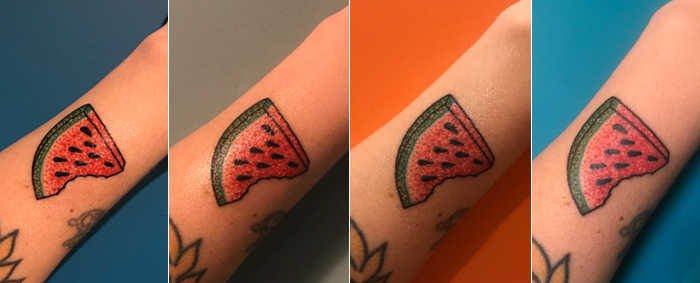



 What Is A Prince Albert Piercing?
What Is A Prince Albert Piercing?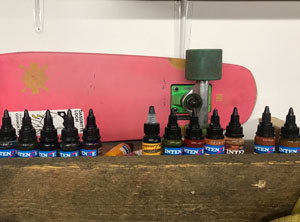 The Best Tattoo Ink 2024
The Best Tattoo Ink 2024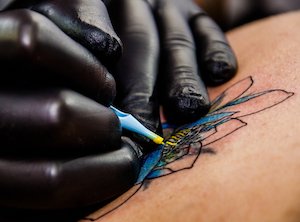 Tattooing Over Stretch Marks, Moles, Scars And Other Skin Conditions
Tattooing Over Stretch Marks, Moles, Scars And Other Skin Conditions 11 Best Fonts For Tattoos 2022
11 Best Fonts For Tattoos 2022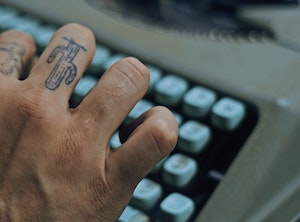 Advice For An Itchy Tattoo
Advice For An Itchy Tattoo